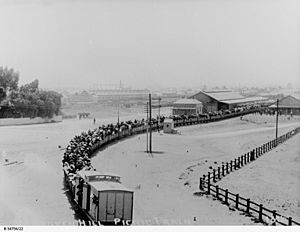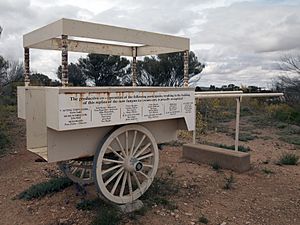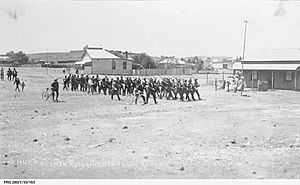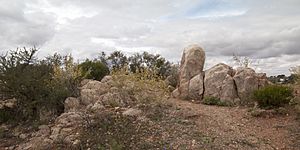1915 Picnic Train Attack and White Rocks Reserve facts for kids
Quick facts for kids 1915 Picnic Train Attack and White Rocks Reserve |
|
|---|---|
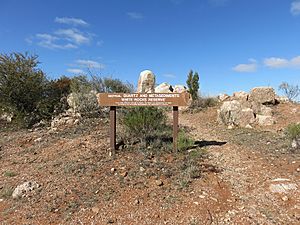
White Rocks Reserve
|
|
| Location | Hynes Street, Broken Hill, City of Broken Hill, New South Wales, Australia |
| Built | 1915–1915 |
| Owner | NSW Department of Industry - Lands; Silverlea Services |
| Official name: 1915 Picnic Train Attack and White Rocks Reserve; The Battle of Broken Hill | |
| Type | state heritage (landscape) |
| Designated | 29 June 2018 |
| Reference no. | 2002 |
| Type | Other - Landscape - Cultural |
| Category | Landscape - Cultural |
| Lua error in Module:Location_map at line 420: attempt to index field 'wikibase' (a nil value). | |
The 1915 Picnic Train Attack and White Rocks Reserve is a special place in Broken Hill, New South Wales, Australia. It's known as the site of the only attack on Australian soil during World War I. This event is also called "The Battle of Broken Hill."
Today, it's a visitor attraction. The land is owned by the NSW Department of Industry - Lands and Silverlea Services. It was added to the New South Wales State Heritage Register in 2018 because of its important history.
Contents
Broken Hill's Early Days
Broken Hill is on the land of the Wilyakali people. They spoke a dialect of the Paakantyi language. In 1845, explorer Charles Sturt first called the area "broken hill."
In 1883, Charles Rasp and his group started mining here. They thought they would find tin. Instead, they found huge amounts of silver, lead, and zinc. These metals made Broken Hill famous.
The city grew very fast. By 1914, it had 35,000 people. This made it the third-largest city in New South Wales. Broken Hill was also Australia's most multicultural city at that time.
Many different people lived here. Afghan cameleers built the Broken Hill mosque in the 1890s. Jewish people from Eastern Europe built a synagogue in 1910. The mosque is still used today.
Mullah Abdullah
Mullah Abdullah was born around 1854-1855. He likely came from Afghanistan or Pakistan. He arrived in Australia around 1890. He started working in Broken Hill in 1899.
Abdullah worked as a cameleer. He was also a mullah for the "Afghans" in the local Ghantown. He led daily prayers and helped with funerals. He was also a halal butcher, preparing meat for Muslims.
He had problems with the local health inspector. This was because of his butchery methods. These issues made him very angry.
Gool Badasha Mahomed
Gool Badasha Mahomed was born in 1875 in Afghanistan. He was an Afridi tribesman. He came to Australia when he was young. He worked as a cameleer.
He later returned home to fight in the Turkish army. He fought in four wars. In 1912, he came back to Australia. He worked in the silver mines of Broken Hill.
When World War I started, Gool felt very strongly about his homeland. He and Mullah Abdullah shared their anger. They decided to plan an attack on a train.
The Silverton Tramway
The Silverton Tramway Company built a private railway. It was 50 kilometers long. The line opened in 1888. It was one of only two private railways in New South Wales.
The tramway first carried ore from mines. But it also carried other goods and passengers. Passenger services made up a third of their business.
The company took people on long trips. They also ran short trips for local groups. These trips often went to Silverton or McCulloch Park. People would have picnics and return to Broken Hill later.
In 1927, a railway from Sydney reached Broken Hill. This connected the Silverton Tramway to the rest of Australia. The tramway was vital for Broken Hill's economy until 1970.
Oddfellows Picnic Day
The Manchester Unity of Oddfellows is a friendly society. It started in England a long time ago. This group helped people who earned less money. They offered support during sickness, injury, or death.
The Broken Hill Oddfellows held a picnic every New Year's Day. They went to Silverton. The Silverton Tramway Company often helped these groups. They cleaned out ore carriages. Then they added benches for passengers.
On New Year's Day 1915, 41 carriages were used. They carried 1,200 men, women, and children. These were all members of the Oddfellows.
The Attack on the Train
The only World War I attack in Australia happened in Broken Hill. It was on New Year's Day 1915. The Oddfellows were going to their annual picnic.
The train left the Sulphide Street railway station around 10 am. About 1.2 kilometers from Railway Town Station, passengers saw two men. It was Gool Mahomed and Mullah Abdulla. They were near the railway line.
The men started shooting at the train. Some passengers first thought it was New Year's Day fun. Others thought they were shooting at rabbits. But the shots were real.
Seventeen-year-old Alma Cowie was hit in the head. She died about 45 minutes later. William Shaw was also shot and died. His 15-year-old daughter, Lucy Shaw, was shot in the elbow but survived. Alfred Millard, who was riding his bike nearby, was shot in the back and died.
The train moved away from the attackers. It stopped further down the line. Injured passengers were taken off. Help was called from Broken Hill.
Mullah Abdullah and Gool Mahomed ran away. They went towards a house. They shot 70-year-old Thomas Campbell, but he survived. Police arrived and chased the men. Constable Robert Mills was shot twice but survived.
The men took cover at a rocky area called White Rocks. Police and military men joined the fight. Many shots were fired. Civilian James Craig was hit by a stray bullet in his backyard. He died hours later at the hospital.
Around 1:00 pm, Abdullah and Mahomed were found. Both had many gunshot wounds. Mullah Abdullah died during the fight. Gool Mahomed was taken to the hospital but died a few hours later.
After the Attack
The attack made people in Broken Hill very angry. Germany and the Ottoman Empire were allies in World War I. People thought the German community helped the attackers.
That night, a crowd gathered. They went to the German Club. They threw stones and set it on fire. The fire brigade tried to help, but their hoses were cut. The club burned down.
The crowd then went towards Ghan Town. Many camel drivers lived there. Police and military stopped them. This prevented more trouble.
German men working in the mines were fired the next day. The Australian Government used the War Precautions Act 1914. This law allowed the government to make special decisions during wartime. It let them hold people from enemy countries. Many people seen as "enemy aliens" were sent to internment camps until the war ended in 1918.
Cameleer History
More than 20,000 camels came to Australia from 1850 to 1900. The cameleers came from many countries. These included Kashmir, Egypt, Persia, and Afghanistan. They were often called "Afghans," even if they were not from Afghanistan.
The Broken Hill Mosque
Broken Hill was a busy place for camel trails. Many "Afghans" lived here. There were two camps of their homes.
The camp in north Broken Hill was called Ghan Town. The first mosque in New South Wales was built here in 1887. It was a place for Muslims to pray.
A smaller mosque was in the west camp. But it moved to the north camp in 1903. This was because the west area was being redeveloped.
The north camp mosque is now on the State Heritage Register. It is still used for prayers. It also has a small museum about cameleer and Muslim history.
What You Can See Today
1915 Picnic Train Attack Site
The attack site has a memorial. It's a replica of a freight wagon. It sits on the side of Picton Sales Yard Road.
The old railway line embankment is still there. It's about 50 meters north of the memorial. The trench where the attackers hid is also nearby.
White Rocks Reserve
This area is a natural rocky outcrop. It's made of white quartz. It's on the edge of Broken Hill. The area is fenced. It has a short walking track. Signs tell the story of the attack. They also explain the local geology and plants.
You can see a replica of the ice cream cart. The two Afghan men used it to hide their weapons. The reserve is now a popular tourist spot. It's part of the Broken Hill Heritage Tours.
Condition of the Sites
The Picnic Train Attack memorial is in good condition. It reminds people of the event. The old railway line is gone, but you can still see where it was. A fence shows how the old railway line was reused.
The White Rocks Reserve is also in good condition. It's a fenced area. It's kept as a tourist attraction. Signs explain the event and the area's geology. The replica ice-cream cart is there too.
The original landscape is mostly the same. The railway line embankment and water pipeline trench are still visible.
Changes Over Time
The area around the attack site has changed a lot since 1915. The railway line is no longer there. The Silverton Tramway Company stopped running in 1970. Much of the old railway line was removed. It was recycled for fences.
The White Rocks site is now a tourist spot. It's on the edge of Broken Hill. It has fences and signs. A replica of the ice-cream cart was made in 1991. A parking lot was also built for visitors.
Why These Sites Are Important
The picnic train attack sites are very important. They show the only World War I incident where Australians were attacked on their own land. This attack happened under a foreign flag. Four people died, and seven were hurt. The two attackers also died.
Even though it was a small event in the war, it greatly affected Broken Hill. It was national news for months. People had different ideas about it. This attack made Australia look for enemies within its own communities. It led to many people being held in internment camps.
These sites are also important because of the "Afghan" cameleers. Many lived in Ghan Town and prayed at the mosque. They also show how German and other migrants were treated during World War I.
The sites also connect to the Manchester Unity of Oddfellows. Their members were attacked on the train. This group has a long history in Australia.
The Picnic Train Attack sites help us understand Australia's multicultural history. The story shows how fear and prejudice can continue over time. It helps us learn about how people were treated.
This event was unique. It was the only known attack by "enemy aliens" in Australia during World War I. The Ottoman flag used by the attackers is a rare piece of evidence.
The sites show how people can be afraid of those who are different. This has been a problem in New South Wales and Australia for a long time. Especially during World War I and II.


